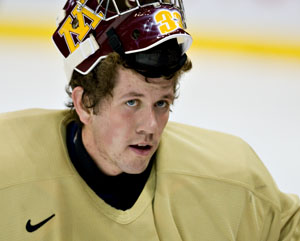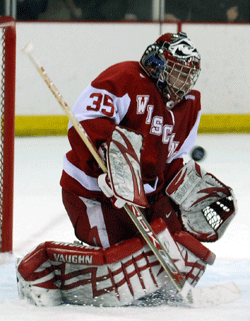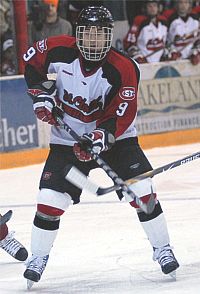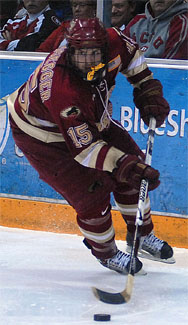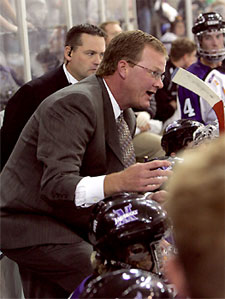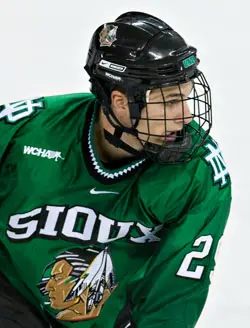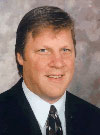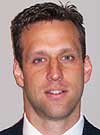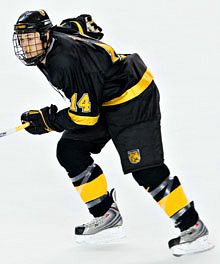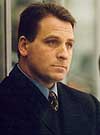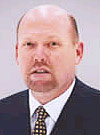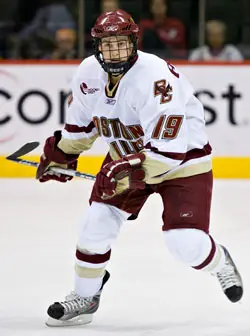Last year, the theme was early departures. This year, there were a few, but nowhere near enough to continue as this year’s theme.
Instead, everyone’s concerned with special teams. Understandably so, given the new rule changes that have been instituted as well as the implementation of the four-official system which was tested last year. The main things teams will have to get used to are:
• Adjustments to the hooking rule. A player can put his stick on the puck carrier, but if he imposes an action (that is, a tug or pull), a penalty will be called.
• Two seconds/two strides. If a defenseman is backing into the zone with a forward, once the forward gets rid of the puck, the defenseman has either two seconds or two strides to hit the forward. If he doesn’t make contact, he has to go play the puck. This basically eliminates defensemen tying up forwards/riding them into the zone.
• Slashing. If Player A uses his stick to make any sort of slashing motion on any part of Player B’s person/stick, it is a penalty.
• Tripping. A trip seems kind of basic, right? Well, there’s a new addition to the tripping rules. If Player A leaves his feet at any time to stop Player B and Player B falls down, it is a tripping call. Example: If Player A, a defenseman, dives to stop Player B and Player B falls down, Player A gets called for tripping regardless of whether he got the puck or not.
• Whistle-blowing. This one’s a bit weird. Before, if there was a mess of bodies in the crease and the puck was missing and somehow found its way into the back of the net, all we cared about was whether the puck went in before or after the whistle, right? Now, not so much. Now, if the puck disappears in the same situation and the puck goes in the net, it may be waved off if the referee was, at some point, in the act of blowing his whistle. This means, that if the puck goes in the net and the ref’s arm is halfway up his body while he’s getting ready to blow the whistle, the goal does not count.
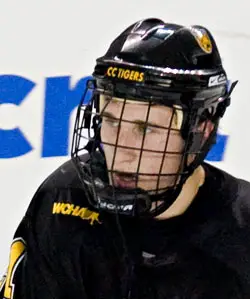
Even though some of these sound confusing, don’t worry — supervisor of officials Greg Shepherd and his team visited every single team and explained everything to them. If not, well, go visit the NCAA’s website. There’s a video explaining all the new rules as well as the rulebook itself.
Back to the Same Old Song and Dance
Like last year and seemingly every year, this league is going to be ridiculously close. Personally, I agree with North Dakota head coach Dave Hakstol when he says that it’s hard to try to predict the order of the teams this year.
“The problem I had going through the polls wasn’t coming up with a group of teams that seemed to fit in the top five, it was when I got to number seven, number eight,” he said. “I would continually write down a team and say, “Well there’s no way in heck these guys are going to be a seventh-place finish team,’ and I’d have to start all over and the top five would again be jumbled.
“It was difficult to put teams in order.”
For me, the very top of the league and the bottom were pretty easy, but spots two through seven? Let’s just say I put my options for Nos. 2 and 3 in a hat and did the same with four through seven. So, if you have a problem with one of those teams being ranked where it is? Blame randomness.
Click on each team name for more detailed analysis.
Head coach: Scott Owens
2007-08 record: 28-12-1 overall, 21-6-1 WCHA (43 points, first of 10 teams)
Key returners: Richard Bachman, G; Chad Rau, F; Bill Sweatt, F
Newcomers to watch: Arthur Bidwell, D; David Civitarese, F
Key losses: Jack Hillen, D; Jimmy Kilpatrick, F
2008-09 predicted finish: First
Bottom line: Last year’s MacNaughton Cup champion is really the only team without a question mark … anywhere.
Head coach: George Gwozdecky
2007-08 record: 26-14-1 overall, 16-11-1 WCHA (33 points, third of 10 teams)
Key returners: Tyler Bozak, F; Patrick Mullen, D; Tyler Ruegsegger, F; Marc Cheverie, G
Newcomers to watch: Joe Colborne, F; Patrick Wiercioch, D
Key losses: Chris Butler, D; Peter Mannino, G
2008-09 predicted finish: Second
Bottom line: Despite losing Mannino, the Pioneers have enough returning as well as enough faith in Cheverie to once again finish near the top of the league.
Head coach: Dave Hakstol
2007-08 record: 28-11-4 overall, 18-7-3 WCHA (39 points, second of 10 teams)
Key returners: Ryan Duncan, F; Joe Finley, D; Chris VandeVelde, F
Newcomers to watch: Brad Eidsness, G; Jason Gregoire, F; David Toews, F
Key losses: Robbie Bina, D; Jean-Philippe Lamoureux, G; T.J. Oshie, F
2008-09 predicted finish: Third
Bottom line: Hakstol will have this team in the mix near the end, iffy goalie situation or not.
Head coach: Troy Jutting
2007-08 record: 19-16-4 overall, 12-12-4 WCHA (28 points, t-fourth of 10 teams)
Key returners: Mick Berge, F; Trevor Bruess, F; Mike Zacharias, G
Newcomers to watch: Cameron Cooper, D; Adam Mueller, F
Key losses: Joel Hanson, F
2008-09 predicted finish: Fourth
Bottom line: The Mavericks return pretty much the same team as last year, which should mean good things for hockey fans in Mankato.
Head coach: Mike Eaves
2007-08 record: 16-17-7 overall, 11-12-5 WCHA (27 points, sixth of 10 teams)
Key returners: Shane Connelly, G; Jamie McBain, D; Ben Street, F
Newcomers to watch: Jake Gardiner, D; Jordy Murray, F; Derek Stepan, F
Key losses: Davis Drewiske, D; Kyle Klubertanz, D; Kyle Turris, F
2008-09 predicted finish: Fifth
Bottom line: If Wisconsin can make it through the first few months of its schedule intact, it will be sitting pretty for home ice.
Head coach: Bob Motzko
2007-08 record: 19-16-5 overall, 12-12-4 WCHA (28 points, t-fourth of 10 teams)
Key returners: Ryan Lasch, F; Garrett Roe, F; Jase Weslosky, G
Newcomers to watch: Jordy Christian, F
Key losses: Aaron Brocklehurst, D; Nate Dey, F; Andreas Nodl, F
2008-09 predicted finish: Sixth
Bottom line: Motzko’s squad did well on the power play last year. If they can repeat that this year, it will help tremendously. A few more goals at even strength and the Huskies might be looking at home ice.
Head coach: Don Lucia
2007-08 record: 19-17-9 overall, 9-12-7 WCHA (25 points, seventh of 10 teams)
Key returners: R.J. Anderson, D; Alex Kangas, G; Ryan Stoa, F
Newcomers to watch: Aaron Ness, D; Jordan Schroeder, F
Key losses: Derek Peltier, D; Blake Wheeler, F
2008-09 predicted finish: Seventh
Bottom line: Kangas returning helps, but unless the WCHA’s largest freshman class makes a huge offensive impact, it’s going to be a long year for the Gopher faithful.
Head coach: Scott Sandelin
2007-08 record: 13-17-6 overall, 9-14-5 WCHA (23 points, eighth of 10 teams)
Key returners: Michael Gergen, F; Josh Meyers, D; Alex Stalock, G
Newcomers to watch: Mike Connolly, F; Jack Connolly, F
Key losses: Matt McKnight, F; Jason Garrison, D
2008-09 predicted finish: Eighth
Bottom line: Sandelin’s scoring by committee didn’t work out too well last year. For the Bulldogs, here’s hoping this year brings better results.
Head coach: Dave Shyiak
2007-08 record: 7-21-8 overall, 3-19-6 WCHA (12 points; 10th of 10 teams)
Key returners: Kevin Clark, F; Paul Crowder, F; Josh Lunden, F; Jon Olthuis, G
Newcomers to watch: Tyler Moir, F
Key losses: Peter Cartwright, F; Merit Waldrop, F
2008-09 predicted finish: Ninth
Bottom line: UAA always seems to be on the cusp of breaking out of the basement. While the Seawolves will probably be near the bottom of the league, I think this is the year they crawl (somewhat) out of the ashes.
Head coach: Jamie Russell
2007-08 record: 14-20-5 overall, 9-15-4 WCHA (22 points, ninth of 10 teams)
Key returners: Geoff Kinrade, D; Rob Nolan, G
Newcomers to watch: Mikael Liektieg, F; Josh Robinson, G
Key losses: Peter Rouleau, F; Tyler Shelast, F; Michael-Lee Teslak, G
2008-09 predicted finish: Tenth
Bottom line: It appears that Tech’s resurgence in the league was short-lived. Unless something drastic happens, it looks like the new black and gold seats in MacInnes will provide the most excitement this winter in Houghton.

